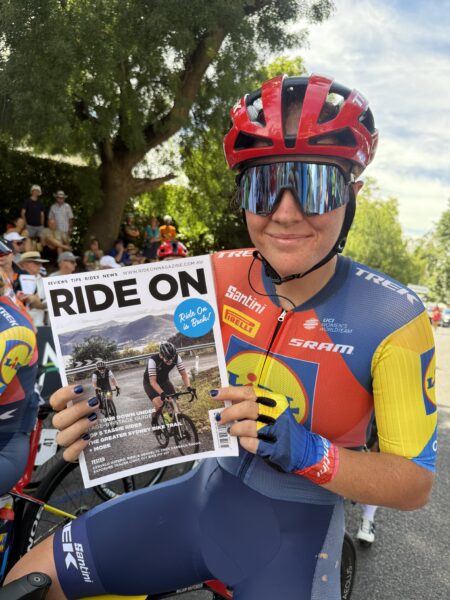How to overtake obstacles
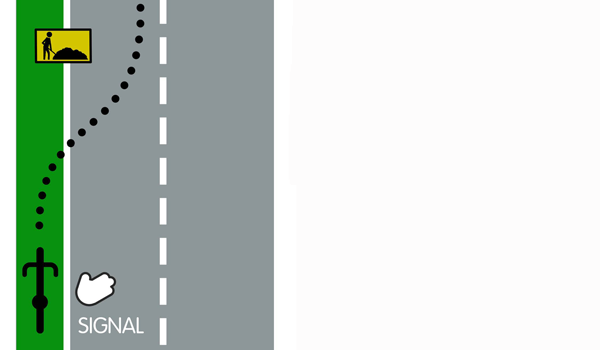
Whether it’s road works, parked cars or a hazard, you will sometimes need to overtake something that’s in the way of where you would like to ride. Simon Vincett explains how it’s done, with illustrations by Karl Hilzinger.
Life is often littered with obstacles and the riding life is no exception. No sweat. It’s just like changing lanes or merging with traffic. You just need to make sure you clearly communicate what you’re doing and take your opportunity with confidence.
This is done with a head check well before the situation (turn your head over your right shoulder to check what traffic is behind you), clear signalling (by holding your arm out to the side that you’ll be moving to) and moving out assertively when the way is clear.
Once you’ve pulled out, ride in a straight line to the outside of the full extent of the obstacle. Don’t pull in to the left if there’s more obstacle ahead to overtake. Riding in a straight line wide of the obstacle keeps you in plain sight and avoids the potential conflict of pulling out again if you had pulled in to the left. [Fig 2]
If you’re not comfortable merging with traffic you can always pull over to the footpath, dismount and push your bike. Once past the obstacle you can get back on the road and ride again.
Let’s have a look at some specific situations.
Road works
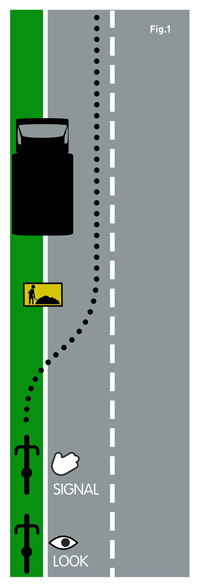
Traffic management staff and equipment around road works are essential to keep workers out of harm’s way. They’re supposed to minimise the impact on traffic flow, but disruption is often unavoidable.
Unfortunately, signs for road works are often set up in the bike lane. You might like to stop and drag them on to the footpath, and perhaps make a friendly request to the traffic management staff to please leave the bike lane clear. Sometimes, a maintenance vehicle or the work site itself is in the bike lane or takes up the left edge of the road.
The result is an overtaking situation, where you will need to move into the traffic lane to your right to pass the obstacle. As early as possible, do a head check to see what traffic is behind you. Stop to give way if necessary. Then indicate to the right and, when the way is clear, merge into the traffic lane beside you. [Fig 1]
‘Cyclists dismount’ signs must be obeyed. If you see one of these, pull over to the footpath, dismount and walk until you can get back on the road and ride on.
If you have to detour and it’s narrow or if there’s any confusion, it’s best to take the lane. Riding in the standard traffic lane removes the temptation for drivers to try to squeeze past you when there isn’t room for them to pass safely. As soon as you’re past the squeeze point you can move to the left again.
Parked cars
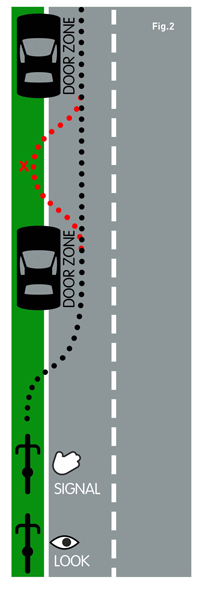 Well before you come to a parked car that you have to overtake—ideally 50 metres from it—start the overtaking process with a head check, which is looking over your right shoulder to see what traffic is behind you. Then signal that you’re moving right by holding your right arm out to the side.
Well before you come to a parked car that you have to overtake—ideally 50 metres from it—start the overtaking process with a head check, which is looking over your right shoulder to see what traffic is behind you. Then signal that you’re moving right by holding your right arm out to the side.
When the way is clear, move right to overtake. Make sure you’re wide of the door zone, which is the width that an open car door sticks out. This is because you can’t be sure whether someone will open the door as you go past. [Fig 2]
If there’s a row of parked cars, continue in a straight line to pass them all at a width that’s clear of the door zone. If there’s a gap in the row of parked cars, don’t move in to the left and then out again; instead, continue in a straight line wide of all the parked cars. If you pull in left you will have to pull out again and deal with potential conflict with passing traffic.
Collisions and hazards
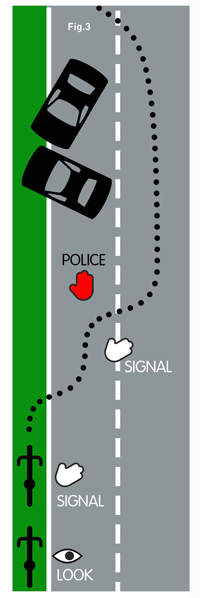 If a collision or hazard is unsupervised when you come to it, call emergency services on 000. Such a traffic situation is high in risk for a vulnerable road user such as a bike rider because everyone is likely to be distracted and conditions are confusing. Riders should slow down and, if necessary, dismount to walk the bike on the footpath.
If a collision or hazard is unsupervised when you come to it, call emergency services on 000. Such a traffic situation is high in risk for a vulnerable road user such as a bike rider because everyone is likely to be distracted and conditions are confusing. Riders should slow down and, if necessary, dismount to walk the bike on the footpath.
When emergency services are in attendance, they will direct the traffic, including bike riders. It is best to merge into the middle of the traffic lane in these situations and to take your turn with confidence. This keeps you in plain sight and makes it clear to everyone what you’re doing. [Fig 3]
Report an obstacle
There are a number of smartphone apps that allow you to report an obstacle directly to the authority responsible, which is the best way to have the obstacle removed as soon as possible. These lead you through a quick process to pinpoint the location, upload a photo, categorise the issue and report the context.
Snap, Send, Solve is the best app in Australia because it directs your report straight to the authority responsible. For instance, if you’re within the City of Hobsons Bay, your email will go directly to that council. It prompts you to upload photos, then poses a few questions to describe the problem. The report is saved in your history for follow up.
The Bike Blackspot app was developed by the Australian Greens “to make life easier and safer for people to ride by highlighting chronic underinvestment in cycling infrastructure.” It promises to contribute to a database that the Greens can use to campaign for cycling infrastructure where it is needed: “When you log a report, your feedback is sent directly via email to your state transport minister, the federal transport minister and your Greens transport spokespeople at state and federal levels. Your report is also logged on the Bike Blackspot map.” An advantage of this app is that you can pinpoint a location without actually being there.
Bicycle Network’s Rider Log app offers an incident report function that delivers a message directly to Bicycle Network. Riders are prompted to add a photo as well. Bicycle Network uses the reports to inform campaigning to improve the riding environment.
See our article ‘How to be a bike advocate’ for more that you can do to improve the riding environment.
Ride On content is editorially independent, but is supported financially by members of Bicycle Network. If you enjoy our articles and want to support the future publication of high-quality content, please consider helping out by becoming a member.



